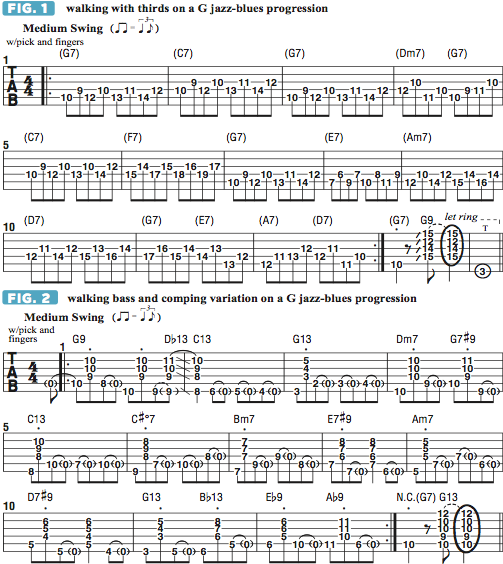Combining "Walking Thirds" and Jazz-Blues Substitutions

In the previous two columns, I demonstrated a couple of cool ways to play “walking bass” accompaniment over a 12-bar jazz-blues progression.
One involved using hybrid picking to down-pick constantly changing bass notes on the lower strings while occasionally plucking staccato “chord stabs” with the fingers on the higher strings. The other way combined walking bass and traditional “flat four” strumming, with a different chord falling on every beat.
I’d now like to offer a technically economical and fun variation that sort of combines the two approaches, plus another example of a “hip” walking-bass-line-with-chord-stabs figure that features more bass-note variations and chord substitutions—slick moves that were invented by adventurous jazz bass, piano and guitar players during the Fifties bebop era and have since become part of the modern jazz rhythm-section vocabulary.
FIGURE 1 is a melodic accompaniment for jazz-blues progression in the key of G that could also serve as a satisfyingly interesting stand-alone part. What we’re doing here is hybrid picking (or straight fingerpicking) third intervals through a series of ascending “walk-ups” from various tonal centers, such as the “one” chord (G7) and the “four” chord (C7).
The figure is performed fairly high up the neck and in the guitar’s middle register overall, but the bass notes, which fall on the downbeats, sound full due to the “fat” tone achieved in this upper region of the fretboard. The fingerpicked higher notes, which are the third intervals, played on the upbeats, provide the rhythmic swing and implied harmony in a playful way that brings to mind left-hand piano “boogie woogie”–style accompaniment.
Notice the use of chromatic passing tones throughout, which serve as “transition notes” that smoothly connect the implied primary chords, the names of which are indicated in parentheses. To minimize the background squeaking that results from dragging your fret-hand fingers along the strings, try to “hop” off each two-note shape immediately after you pluck the second note, which will also give you a more staccato (short and detached) articulation and a clearer sound.
Our second musical example (FIGURE 2) is also performed with hybrid picking and offers another example of a walking bass line over jazz-blues changes in G, with open-string pull-offs liberally employed as “ghost notes” and staccato fingerpicked chord stabs sparsely interjected on the D, G and B strings. After plucking each chord, quickly mute, or “choke,” it by momentarily relaxing your fret hand’s grip on the strings.
There are a few abrupt position shifts, which I deliberately included for the sake of keeping the bass notes and pull-offs “bouncing” along the bottom two strings, so start out at a fairly laid-back tempo and physically memorize the movement before attempting to play the figure more quickly. You’ll find that every open-string pull-off buys your fret hand valuable time to move to the next bass note, similar to what typically happens when you briefly let go of the strings while strumming and switching “cowboy” chords.
Bars 11 and 12 feature an intriguing turnaround, in which tritone substitutions are employed in place of the more traditional and expected “one-six-two-five” (G7-E7-A7-D7) cadence, which we had used in FIGURE 1.
String Theory September 2016 FIGURE 1
String Theory September 2016 FIGURE 2

Get The Pick Newsletter
All the latest guitar news, interviews, lessons, reviews, deals and more, direct to your inbox!
Over the past 30 years, Jimmy Brown has built a reputation as one of the world's finest music educators, through his work as a transcriber and Senior Music Editor for Guitar World magazine and Lessons Editor for its sister publication, Guitar Player. In addition to these roles, Jimmy is also a busy working musician, performing regularly in the greater New York City area. Jimmy earned a Bachelor of Music degree in Jazz Studies and Performance and Music Management from William Paterson University in 1989. He is also an experienced private guitar teacher and an accomplished writer.
“There are so many sounds to be discovered when you get away from using a pick”: Jared James Nichols shows you how to add “snap, crackle and pop” to your playing with banjo rolls and string snaps
Don't let chord inversions bamboozle you. It's simply the case of shuffling the notes around








![Joe Bonamassa [left] wears a deep blue suit and polka-dotted shirt and plays his green refin Strat; the late Irish blues legend Rory Gallagher [right] screams and inflicts some punishment on his heavily worn number one Stratocaster.](https://cdn.mos.cms.futurecdn.net/cw28h7UBcTVfTLs7p7eiLe.jpg)


